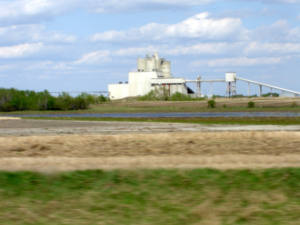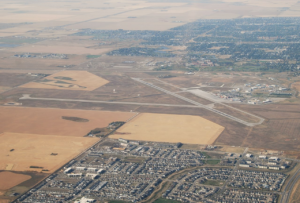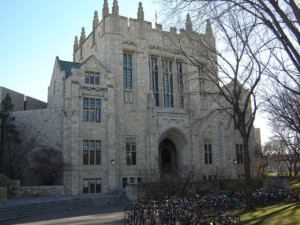
Saskatchewan is a prairie and boreal province in Western Canada, the middle of the three Prairie Provinces. It is bordered on the west by Alberta, on the north by the Northwest Territories, on the east by Manitoba, to the northeast by Nunavut, and on the south by the U.S. states of Montana and North Dakota. Saskatchewan, along with Alberta make up the only landlocked provinces of Canada. As of Q1 2020, Saskatchewan’s population was estimated at 1,181,987.[7] Nearly 10% of Saskatchewan’s total area of 651,900 square kilometers (251,700 sq. mi) is fresh water, which is composed mostly of rivers, reservoirs, and the province’s 100,000 lakes.
Residents primarily live in the southern prairie half of the province, while the northern boreal half is mostly forested and sparsely populated. Of the total population, roughly half live in the province’s largest city Saskatoon or the provincial capital Regina. Other notable cities include Prince Albert, Moose Jaw, Yorkton, Swift Current, North Battleford, Melfort, and the border city Lloydminster (partially within Alberta). English is the primary language of the province, with 82.4% of Saskatchewanians speaking English as their first language.
The Saskatchewan Legislative Building
Saskatchewan receives more hours of sunshine than any other Canadian province. The province lies far from any significant body of water. This fact, combined with its northerly latitude, gives it a warm summer, corresponding to its humid continental climate in the central and most of the eastern parts of the province, as well as the Cypress Hills; drying off to a semi-arid steppe climate in the southwestern part of the province. Drought can affect agricultural areas during long periods with little or no precipitation at all. The northern parts of Saskatchewan – from about La Ronge northward – have a subarctic climate with a shorter summer season. Summers can get very hot, sometimes above 38 °C (100 °F) during the day, and with humidity decreasing from northeast to southwest. Warm southern winds blow from the plains and intermountain regions of the Western United States during much of July and August, very cool or hot but changeable air masses often occur during spring and in September. Winters are usually bitterly cold, with frequent Arctic air descending from the north with high temperatures not breaking −17 °C (1 °F) for weeks at a time. Warm chinook winds often blow from the west, bringing periods of mild weather. Annual precipitation averages 30 to 45 centimeters (12 to 18 inches) across the province, with the bulk of rain falling in June, July, and August.

Photo: A Potash Corp mine in Patience Lake
Historically, Saskatchewan’s economy was primarily associated with agriculture, with wheat being the precious symbol on the province’s flag. Increasing diversification has resulted in agriculture, forestry, fishing, and hunting only making up 8.9% of the province’s GDP in 2018. Saskatchewan grows a large portion of Canada’s grain. In 2017, the production of canola surpassed the production of wheat, which is Saskatchewan’s most familiar crop and the one most often associated with the province.
Saskatchewan is the world’s largest exporter of mustard seed. Beef cattle production by a Canadian province is only exceeded by Alberta. In the northern part of the province, forestry is also a significant industry. Mining is a major industry in the province, with Saskatchewan being the world’s largest exporter of potash and uranium.
Oil and natural gas production is also a very important part of Saskatchewan’s economy, although the oil industry is larger. Among Canadian provinces, only Alberta exceeds Saskatchewan in overall oil production. Natural gas is found almost entirely in the western part of Saskatchewan, from the Primrose Lake area through Lloydminster, Unity, Kindersley, Leader, and around Maple Creek areas.
Major Saskatchewan-based Crown corporations are Saskatchewan Government Insurance (SGI), SaskTel, SaskEnergy (the province’s main supplier of natural gas), and SaskPower. Bombardier runs the NATO Flying Training Centre at 15 Wing, near Moose Jaw.

Photo: Aerial view of Regina International Airport (CYQR) in Regina, Saskatchewan
The Saskatoon Airport (YXE) and the Regina International Airport (YQR) are the main airports in Saskatchewan. Airlines offering service to Saskatchewan are Air Canada, WestJet Airlines, Transwest Air, Norcanair Airlines, La Ronge Aviation Services Ltd, La Loche Airways, Osprey Wings Ltd, Buffalo Narrows Airways Ltd, Skyservice Airlines, Île-à-la-Crosse Airways Ltd, Voyage Air, Pronto Airways, Venture Air Ltd, Pelican Narrows Air Service, Jackson Air Services Ltd, and Northern Dene Airways Ltd.
Urban, suburban, and interurban transport has included streetcars, electric railways, electric trolleys (trolley buses), motor buses, and motor coaches.
The main Saskatchewan waterways are the North Saskatchewan River or South Saskatchewan River routes. Early ferry service and steamship travel were employed on the major waterways. Barges for freight transfer have used the Athabasca River servicing Uranium City, Fond du Lac, Stony Rapids, and Black Lake. Wollaston Lake barge services Wollaston Lake. There are currently twelve ferry services operating in the province, all under the jurisdiction of the Department of Highways.

Photo: Thorvaldson building University of Saskatchewan
Education in Saskatchewan is generally divided as Elementary (primary school, public school), followed by Secondary (high school) and Post-secondary (university, college). Within the province under the Ministry of Education, there are district school boards administering the educational programs.
There are three universities in Saskatchewan. The First Nations University of Canada and the University of Regina are both in Regina, the province’s capital, and the University of Saskatchewan is in Saskatoon, the most populous city in Saskatchewan. The University of Saskatchewan is the oldest university in the province, founded in 1907, and the First Nations University of Canada is the newest, established in 1976. The University of Saskatchewan is also the largest university in Saskatchewan with 18,620 students, and the First Nations University of Canada (FNUC) is the smallest with 840 students. The First Nations University is the only Canadian university that caters to the needs of First Nations students. It was originally called the Federation of Saskatchewan Indian Nations, and once formed, it entered into a federated agreement with the University of Regina to create the Saskatchewan Indian Federated College (SIFC). This Agreement allowed FNUC to become an independently administered university-college that served First Nations students. The First Nations University of Canada is the only university in the province that does not offer graduate-level programs.
Source of the majority of Photos and Content of this page: Wikipedia
It is your duty in life to save your dream
AMEDEO MODIGLIANI